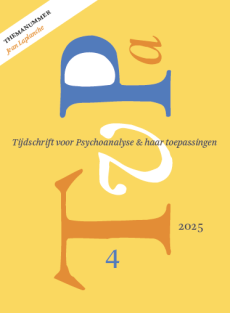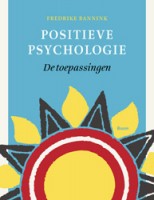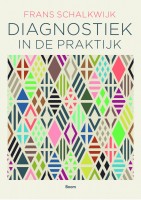Neurotische en perverse processen
Summary
Neurotic and perverse processes
Currently in psychoanalysis there is a broader conception of perversion and perversity. The core of the perverse lies in a fundamental disturbance in the fantasizing and symbolizing of reality. This leads to a splitting of the ego and a disavowal which may occur at each developmental stage with the arousal of anxious and depressive affects in face of a new, threatening reality which is sensed as traumatic. Perverse processes during psychoanalytic treatment are often veiled by simultaneous neurotic processes. This is illustrated by three clinical vignettes of patients who in initial interviews were assessed as mainly neurotic.
Literatuur
- Arlow, J.A. & Baudry, F.D. (2002). Madame Bovary A study in envy and revenge. Psychoanalytic Quarterly, 71, 213-233.
- Campbell, D. (2007). Technical difficulties and challenges in psychoanalytic work with perverse patients. Ongepubliceerde voordracht en discussie op het ipacongres te Berlijn.
- Coen, S.J. (1985). Perversion as a solution to intrapsychic conflict. Journal of the American Psychoanalytic Association, 33 (suppl.), 17-57.
- Coen, S.J. (1998). Perverse defenses in neurotic patients. Journal of the American Psychoanalytic Association, 46, 1169-1194.
- Coultre, R. le & Sterren, H.A. van der (1963). Masochisme. In Th. Hart de Ruyter (red.), Capita selecta uit de kinder- en jeugdpsychiatrie (p. 217-234). Antwerpen: N.V. Standaard Boekhandel.
- Danckwardt, J.F. (2007). From Dream Story (Schnitzler) to Eyes wide shut (Kubrick) From identity through meaning formation to identity through excitation. International Journal of Psychoanalysis, 88, 735-753.
- De Masi, F. (2007). The paedophile and his inner world. International Journal of Psychoanalysis, 88, 147-167.
- Etchegoyen, R.H. (1991). The fundamentals of psychoanalytic technique. Londen: Karnac.
- Freud, S. (1905). Drei Abhandlungen zur Sexualtheorie. Studienausgabe 5 (p. 47-145). Frankfurt am Main: S. Fischer Verlag.
- Freud, S. (1919). Ein Kind wird geschlagen Beitrag zur Kenntnis der Entstehung sexueller Perversionen. Studienausgabe 7 (p. 231-254). Frankfurt am Main: S. Fischer Verlag.
- Freud, S. ( 1927). Fetischismus. Studienausgabe 3 (p. 383-388). Frankfurt am Main: S. Fischer Verlag.
- Freud, S. ( 1938). Die Ichspaltung im Abwehrvorgang. Studienausgabe 3 (p. 391-394). Frankfurt am Main: S. Fischer Verlag.
- Freud, S. (1940). Abriss der Psychoanalyse. Gesammelte Werke 17 (p. 63-138). Frankfurt am Main: S. Fischer Verlag.
- Glasser, M. (1986). Identification and its vicissitudes as observed in the perversions. International Journal of Psychoanalysis, 67, 9-17.
- Good, M.I. (2006). Perverse dreams and dreams of perversion. Psychoanalytic Quarterly, 75, 1005-1045.
- Grossman, L. (1993). The perverse attitude toward reality. Psychoanalytic Quarterly, 57, 422-437.
- Jiménez, J.B. (2004). A psychoanalytical phenomenology of perversion. International Journal of Psychoanalysis, 85, 65-82.
- Joseph, B. (1971). A clinical contribution to the analysis of perversion. International Journal of Psychoanalysis, 52, 441-449.
- Kahn, M.M.R. (1979). Alienation in perversions. Londen: Hogarth Press.
- Kernberg, O.F. (1992). Aggression in personality disorders and perversions. New York / Londen: Yale University Press.
- Kernberg (2006). Perversion, perversity and normality. In D. Nobus & L. Downing, Perversion (p. 19-40). Londen: Karnac Books.
- Kohon, G. (1987). Fetishism revisited. International Journal of Psychoanalysis, 68, 213-228.
- Laplanche, J. & Pontalis, J.B. (1973). The language of psycho-analysis. Londen: The Hogarth Press.
- Purcell, S. (2006). The analysts excitement in the analysis of perversion. International Journal of Psychoanalysis, 87, 105-123.
- Richards, A. (2003). A fresh look at perversion. Journal of the American Psychoanalytic Association, 51, 1199-1218.
- Sanchez-Medina, A. (2002). Perverse thought. International Journal of Psychoanalysis, 83, 1345-1359.
- Smith, H.F. (2006). Analyzing disavowed action. Journal of the American Psychoanalytic Association, 54, 713-737.
- Socarides, C.W. (2004). A psychoanalytic classification of the paedophilias: two clinical illustrations. In C. W. Socarides & L. R. Loeb (red.), The mind of the paedophile Psychoanalytic perspectives (p. 7-62). Londen: Karnac.
- Stein, R. (2005). Why perversion? False love and the perverse pact. International Journal of Psychoanalysis, 86, 775-799.
- Stoller, R.J. (1991). The term perversion. In G. I. Fogel & W. A. Meyers (red.), Perversions and near-perversions in clinical practice New psychoanalytic perspectives (p. 36-56). New Haven CT: Yale University Press.
- Ubbels, J. (1996). Perversie en pervertering van de overdracht. Tijdschrift voor Psychoanalyse, 2, 133-145.
- Zimmer, R. (2003). Perverse modes of thought. Psychoanalytic Quarterly, 72, 905-938.
 © 2009-2025 Uitgeverij Boom Amsterdam
© 2009-2025 Uitgeverij Boom Amsterdam
ISSN 1382-516x
De artikelen uit de (online)tijdschriften van Uitgeverij Boom zijn auteursrechtelijk beschermd. U kunt er natuurlijk uit citeren (voorzien van een bronvermelding) maar voor reproductie in welke vorm dan ook moet toestemming aan de uitgever worden gevraagd:
Behoudens de in of krachtens de Auteurswet van 1912 gestelde uitzonderingen mag niets uit deze uitgave worden verveelvoudigd, opgeslagen in een geautomatiseerd gegevensbestand, of openbaar gemaakt, in enige vorm of op enige wijze, hetzij elektronisch, mechanisch door fotokopieën, opnamen of enig andere manier, zonder voorafgaande schriftelijke toestemming van de uitgever.
Voor zover het maken van kopieën uit deze uitgave is toegestaan op grond van artikelen 16h t/m 16m Auteurswet 1912 jo. Besluit van 27 november 2002, Stb 575, dient men de daarvoor wettelijk verschuldigde vergoeding te voldoen aan de Stichting Reprorecht te Hoofddorp (postbus 3060, 2130 KB, www.reprorecht.nl) of contact op te nemen met de uitgever voor het treffen van een rechtstreekse regeling in de zin van art. 16l, vijfde lid, Auteurswet 1912.
Voor het overnemen van gedeelte(n) uit deze uitgave in bloemlezingen, readers en andere compilatiewerken (artikel 16, Auteurswet 1912) kan men zich wenden tot de Stichting PRO (Stichting Publicatie- en Reproductierechten, postbus 3060, 2130 KB Hoofddorp, www.cedar.nl/pro).
No part of this book may be reproduced in any way whatsoever without the written permission of the publisher.
Nieuwsbrief Boom Psychologie
Meld u nu aan en ontvang maandelijks de Boom Psychologie nieuwsbrief met aantrekkelijke aanbiedingen en de nieuwe uitgaven.
Aanmelden


